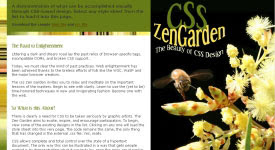- Home pages - strategies include menu list of links, news-oriented front page, path-based split, splash screen - or a combination of these.
- Graphics or text - visual design versus usability/seo
- Master page layout grid - a standard layout for all pages, not dominated by homepage design
- Menus and subsites - grouping sections together into digestible chunks
- Resource lists, links to related sites
- Tables of contents, site maps, site indexes
- "What's New?" pages - for regular visitors
- Search features - for large sites
- FAQ pages
- Custom error pages
* Web Style Guide - Planning, Lynch & Horton (2004)
* Text & Graphical layout based on principles by Robin Williams & John Tollet, Brian Josephson (2002)
* Screen Design Research, Bonnie Skaalid (1999)
* Writing for the Web: Elements of Effective Screen Design, Dr. Stuart Blythe (2001)
* Visual Literacy, Screen design, Betty Hennessy (n.d)
* Screen Design, keithpeterb on Youtube
* The Need for Web Design Standards, Jakob Nielsen (2004)
* Elements of style for web design, Christine A. Quinn (n.d)
* Principles and Elements of Design, Joshua David McClurg-Genevese (2006)
* Elements of Interface Design, Virginia Tech
* Design Rules, Anna Muoio and Lucy A. McCauley (1999)
* Elements of Design Applied to the Web, Kyle Meyer (2007)
* Elements of Web Design Today, Hyder Jaffari (2007)
Navigation:
- All about organising information using logic, hierarchy to structure relationships
- Information best presented in short "chunks"
- Hierarchies ranked by importance, organised by interrelationships
- Logical/predictable organisation helps users know where to find things
- The "three click rule"
- Four navigational/site structures - sequences, hierarchies, grids, webs
Links - Navigation
* Basics of Navigation, Sean Timberlake (2000)
* Navigation, Joe Gillespie (2000)
* Basic Principles of Web Site Navigation, Charlie Morris (1999)
* Website Navigation, Ross Shannon (2007)
* Website navigation is useful, Adam Baker (2001)
* Where am I?, Derek Powazek (2006)
